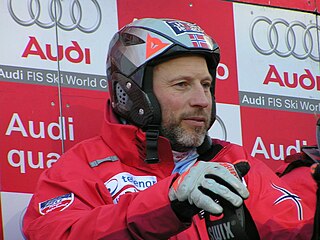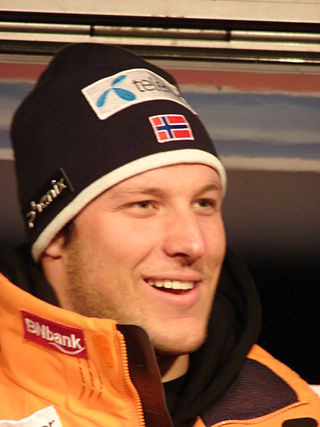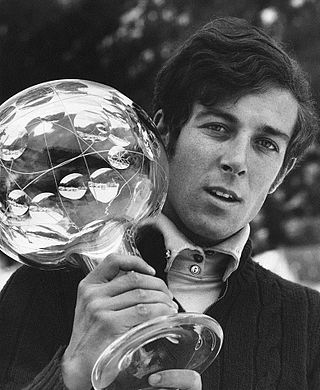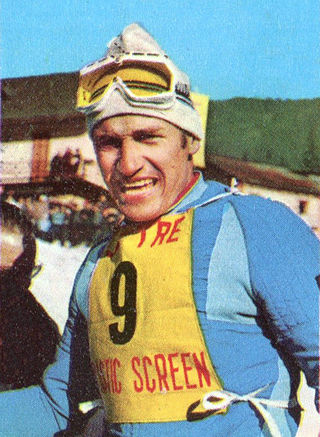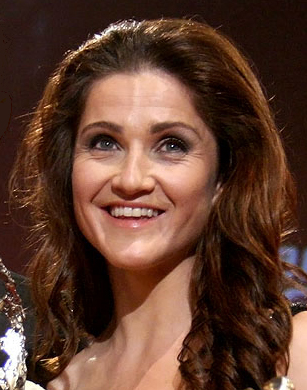Early career
Killy turned his attention to skiing rather than school. His father allowed him to drop out at age 15, and he made the French national junior team a year later. As a young racer, Killy was fast, but did not usually complete his races, and the early 1960s were not entirely successful for him. [1]
In December 1961, at age 18, Killy won his first international race, a giant slalom. The event took place in his home village of Val-d'Isère. Killy had started 39th, a position that should have been a severe disadvantage. [1]
The French coach picked Killy for the giant slalom in the 1962 World Championships in Chamonix, France, 50 miles (80 km) away in the shadow of Mont Blanc. But Killy, unaware of his selection, was still attempting to qualify for the downhill event in northeastern Italy at Cortina d'Ampezzo. Only three weeks before the world championships, he skied in his typical reckless style. About two hundred yards (180 m) from the finish, Killy hit a stretch of ice in a compression and went down, rose immediately, then crossed the finish on just one ski—and the fastest time. Unfortunately, his other leg was broken, and he watched the 1962 World Championships on crutches. [1]
Two years later, at age 20, Killy was entered in all three of the men's events at the 1964 Olympics, because his coach wanted to prepare him for 1968. Unfortunately, Killy was plagued by recurrences of amoebic dysentery and hepatitis, ailments that he had contracted in 1962 during a summer of compulsory service with the French Army in Algeria. His form was definitely off, and he fell a few yards after the start of the downhill, lost a binding in the slalom, and finished fifth in the giant slalom, in which he had been the heavy favorite. [1] Yet a few weeks later, he dominated a giant slalom race at Garmisch-Partenkirchen, in Bavaria, counting for the prestigious Arlberg-Kandahar events, the oldest 'classic' in the sport. A year later, he also triumphed at another major competition, the slalom of the Hahnenkamm races at Kitzbühel that he clinched three times in a row until 1967.
Although the first half of the decade was a relative disappointment, Killy began to strongly improve his results afterwards to become one of the best technical ski racers. In August 1966, the Frenchman, nicknamed 'Toutoune' by some of his colleagues and friends, scored his first win in a downhill race against an international field at the 1966 World Championships in Portillo, Chile, and also took gold in the combined. Killy was peaking as the first World Cup season was launched in January 1967, with the 1968 Winter Olympics in France only a year away.
Post-Olympic career
Killy's success in Grenoble could not have come at a more opportune time for him: the 1968 Winter Olympics were the first to be extensively televised, in color, by the American Broadcasting Company. His all-conquering success, combined with his Gallic flair and looks, made him an overnight celebrity in the United States, especially amongst young women. In May 1968, Killy signed with International Management Group, the sports management firm headed by Mark McCormack. After racing on Dynamic VR17 and Rossignol skis during the part of his career when he was dominant, Killy signed a deal with Head Ski in the fall 1968 to endorse a metal and fiberglass ski named for him, the Killy 800. [2] [3] Head, which was acquired by AMF the following year, manufactured a line of Killy skis for at least two years.
In April 1969, he was awarded the Helms World Trophy. [4]
In television advertisements, Killy promoted the American Express card. He also became a spokesman for Schwinn bicycles, United Airlines, and Chevrolet automobiles; the last, a role detailed by journalist Hunter S. Thompson in his 1970 article "The Temptations of Jean-Claude Killy" for Scanlan's Monthly .
Killy starred as a ski instructor in the 1972 crime movie Snow Job, released in the UK as The Ski Raiders, and US TV as The Great Ski Caper. American children in the early 1970s knew Killy from a TV commercial where he introduces himself, his thick accent making his name into "Chocolate Kitty." Killy played himself in the 1983 movie Copper Mountain: A Club Med Experience, starring Jim Carrey and Alan Thicke, set at Copper Mountain, Colorado. Killy also stars in the noteworthy TV movie Peggy Fleming at Sun Valley (1971), in which he performs some remarkable skiing tricks alongside the three-time ice skating World Champion Peggy Fleming.
Jean-Claude Killy also had a short career as a racing driver between 1967 and 1970, participating in several car races including at Monza. Killy entered the 24 Hours of Le Mans in 1969, partnered with Bob Wollek, another former skier turned racing driver. Killy and Wollek's car led its class for a while before pulling out of the race with only four hours to go. In team with fellow Frenchman Bernard Cahier, Killy was 7th overall in the 1967 Targa Florio in a Porsche 911 S and first in the GT classification.
In November 1972, Killy came out of ski racing retirement at age 29 to compete on the pro circuit in the U.S. for two seasons. After a spirited challenge from two-time defending champion Spider Sabich, Killy won the 1973 season title, taking $28,625 in race winnings and a $40,000 bonus for the championship. [5] [6] He missed the next season, won by Hugo Nindl, [7] due to a recurring stomach ailment, then returned in the fall of 1974. [8] [9] [10] Injuries slowed him and he finished well out of the 1975 standings, won by Hank Kashiwa.
In addition to trying his skill as a car racer, Killy made two television series. One, The Killy Style, was a thirteen-week series that showcased various ski resorts, and the other, The Killy Challenge, featured him racing against celebrities, who were all given handicaps. He was also sponsored by a champagne company, Moët & Chandon, which paid him to be seen with a bottle of their champagne on his table everywhere he went. In 1974 Killy, as part of this sponsorship deal was paid to ski down the previously unskied eastern slope of Mt Ngauruhoe (Peter Jackson's "Mt Doom") in New Zealand. The average slope on this side of the active volcano is 35 degrees. Radar recorded his speed at over 100 mph (160 km/h), and it took two takes, as cloud cover spoiled the first.
In 1975, Killy was hired to lead the new ski operations at Shawnee Mountain Ski Area, a resort in the foothills of the Pocono Mountains in northeastern Pennsylvania. [11] [12] [13] In 1983, Bob Gillen wrote in Ski magazine about the growing reputation of Shawnee Mountain as a ski area. He stated, "Some of the initial interest was stimulated by hiring Jean-Claude Killy to represent the facility, and for several seasons he spent a number of days there. The first time my wife ever skied with me, I saw Killy flash by at Shawnee—he was fast and smooth and he stopped frequently to check the time on his Rolex." [11]
From 1977 to 1994, he was a member of the Executive board of the Alpine Skiing Committee of the FIS. Killy served as co-president of the 1992 Winter Olympics, held in Albertville, France, and as the President of the Société du Tour de France cycling race between 1992 and 2001. From 1995 to 2014, he was a member of the International Olympic Committee and chaired the coordination committee for Turin 2006 and Sochi 2014. [14] He has been an Honorary Member since then. [15]
Killy tried his hand at distance running and competed in the 1983 New York City Marathon, finishing in 3:58:33. [16]
The ski area of Val-d'Isère and Tignes in the French Alps was given the name l'Espace Killy, in his honor. [17] [18]
Killy became Grand Officer of the Légion d'honneur in 2000.
Intrawest credits Killy with the design of a ski trail, "Cupp Run", at their Snowshoe resort in West Virginia.



